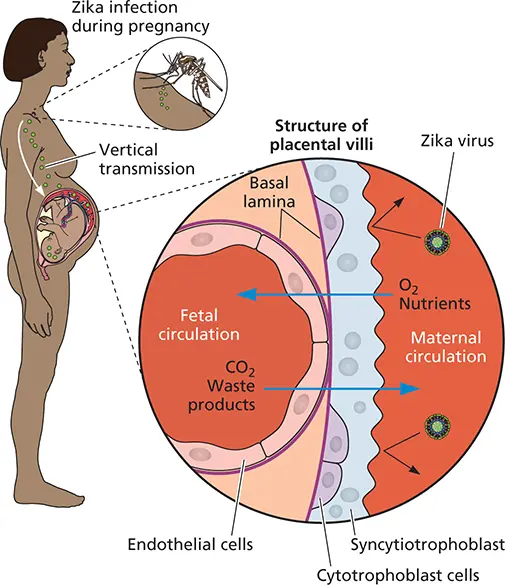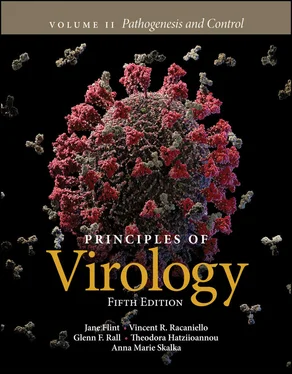S. Jane Flint - Principles of Virology, Volume 2
Здесь есть возможность читать онлайн «S. Jane Flint - Principles of Virology, Volume 2» — ознакомительный отрывок электронной книги совершенно бесплатно, а после прочтения отрывка купить полную версию. В некоторых случаях можно слушать аудио, скачать через торрент в формате fb2 и присутствует краткое содержание. Жанр: unrecognised, на английском языке. Описание произведения, (предисловие) а так же отзывы посетителей доступны на портале библиотеки ЛибКат.
- Название:Principles of Virology, Volume 2
- Автор:
- Жанр:
- Год:неизвестен
- ISBN:нет данных
- Рейтинг книги:3 / 5. Голосов: 1
-
Избранное:Добавить в избранное
- Отзывы:
-
Ваша оценка:
- 60
- 1
- 2
- 3
- 4
- 5
Principles of Virology, Volume 2: краткое содержание, описание и аннотация
Предлагаем к чтению аннотацию, описание, краткое содержание или предисловие (зависит от того, что написал сам автор книги «Principles of Virology, Volume 2»). Если вы не нашли необходимую информацию о книге — напишите в комментариях, мы постараемся отыскать её.
Volume I: Molecular Biology
Volume II: Pathogenesis and Control
Principles of Virology, Fifth Edition
Principles of Virology, Volume 2 — читать онлайн ознакомительный отрывок
Ниже представлен текст книги, разбитый по страницам. Система сохранения места последней прочитанной страницы, позволяет с удобством читать онлайн бесплатно книгу «Principles of Virology, Volume 2», без необходимости каждый раз заново искать на чём Вы остановились. Поставьте закладку, и сможете в любой момент перейти на страницу, на которой закончили чтение.
Интервал:
Закладка:
While some perinatal infections can be avoided by Caesarian delivery, in utero infections cannot. Historically, the primary transplacental viral infections of concern were rubella, cytomegalovirus, and herpes simplex virus. These viruses, along with the parasite Toxoplasma , comprised the four pathogens once defined by the acronym TORCH. Infection by any of these pathogens poses a substantial threat to the fetus. For example, the risk of fetal infection in mothers who are infected with rubella virus during the first trimester is approximately 80%. Similarly, intrauterine transmission of human cytomegalovirus occurs in approximately 40% of pregnant women with primary infection.
The recent Zika virus outbreak and appearance of birth defects in children born following in utero infection focused greater attention on transplacental virus infections ( Fig. 2.10). The placenta is the sole barrier and conduit between the maternal and fetal blood supply and is responsible for gas, waste, and nutrient exchange throughout pregnancy, and its morphology and constitution change throughout pregnancy. Syncytiotrophoblasts lie at the maternal-fetal blood interface and are in direct contact with maternal blood; they are therefore crucial for protecting the fetus from circulating pathogens. Indeed, the syncytiotrophoblast layer is highly resistant to viral infections, including by teratogenic viruses such as rubella, cytomegalovirus, and Zika virus. The mechanisms by which teratogenic viruses cross the placenta are largely unknown, and there may be multiple mechanisms of trans mission to the fetus. Some pathways that have been proposed to allow for viral vertical transmission include traversing the syncytiotrophoblast layer by antibody-dependent transcytosis, increased tropism for placental cell types that are more permissive to virus infections, and maternal immune-mediated damage to the syncytiotrophoblast layer, thus allowing for breaches in the placental barrier. Alternatively, herpes simplex virus may spread from the ascending intravaginal route to infect the fetus, thereby bypassing the syncytiotrophoblast layer altogether.

Figure 2.10 Transplacental virus infections. Several viruses, including Zika virus, rubella virus, cytomegalovirus, and herpes simplex virus, can cross from mother to fetus. How these vertically transmitted infections might occur is dependent on multiple variables including virus type and fetal age. Syncytiotrophoblasts are crucial cells that lie at the maternal-fetal interface and are resistant to infection by many viruses. Routes of vertical transmission across the placenta could include breaks in the syncytial cell layer, targeting other cell types such as cytotrophoblasts or extravillous trophoblasts, or bypassing this by mechanisms such as direct antibody-mediated transcytosis.
Although the portals described above are all anatomical “gateways” by which viruses (and other pathogens) may cross barriers to initiate an infection, human cognition and intuition may also influence the viral pathogens to which we may be exposed ( Box 2.6).
Viral Tropism
The previous sections discuss viral access to particular tissues, and entry points into the host. But there is more to initiating an infection than just access. Before describing how viruses move throughout an infected host, it will be useful to discuss briefly the concept of viral tropism: the cellular and anatomical parameters that define the cells in which a virus can reproduce in vivo . Most viruses are restricted to specific cell types in certain organs. Tropism is governed by at least four parameters. First, in order for a virus to infect a cell, the cell must be susceptible; that is, it must have receptors that the virus binds to allow entry. However, expression of an entry receptor and translocation into the cytoplasm is not sufficient to ensure virus reproduction. Successful production of viral progeny depends on cellular gene products (or other cellular components) to complete the infectious cycle, which may be synthesized by some cell types but not others. The presence of such proteins and molecules renders the cell permissiveto completion of the virus reproduction cycle and release of infectious virus particles. Although a cell may be both susceptible and permissive, infection may not occur because virus particles are physically prevented from interacting with the tissue; thus, the host cells must be accessible to virus. Finally, an infection may not progress, even when the tissue is accessible and the cells are susceptible and permissive, because of intrinsic and innate immune defenses that resolve the infection before spread can occur.
BOX 2.6
DISCUSSION
Is intuition a host defense?
As sentient humans (and animals), we are constantly surveying our environment for dangers and opportunities. Such senses help all organisms to evade predation and to locate food sources but may also be useful in avoiding infections. For example, a rather typical human behavior upon locating some food toward the back of the refrigerator is to sniff it to see if it is still “good,” and people are usually quite adept at knowing when food is no longer acceptable to eat based on smell and appearance. In principle, food surveillance is a kind of quality control to ensure that the items we eat do not carry dangerous microbes. Similarly, avoiding a murky hot tub or declining the advances of a dubious sexual partner could also be considered finely honed skills that may help to avoid contact with pathogens.

The cells in which a virus reproduces obviously influence the kind of disease that can occur, and thus tropism is a crucial parameter of pathogenesis. Human herpes simplex virus is considered neurotropic because of its ability to infect, and be reactivated from, the nervous system, but in fact, this virus can reproduce in many cells and tissues in the host. In most hosts, a localized infection occurs at the site of infection, followed by latent infection of neurons that innervate that tissue. In some individuals with weakened immune systems, such as neonates and the elderly, the virus may cause viremia, enabling access to distal organs, or may cross from the peripheral nervous system to the central nervous system. While rare, both of these outcomes pose serious risk for long-term disease.
Accessibility of Viral Receptors
A cell may be susceptible to infection if the viral receptor(s) is present and functional. However, the receptor may not be accessible. For example, if the cellular receptor is present only on the basal cell membrane of polarized epithelial cells, a virus that is only exposed to the apical cell surface cannot infect unless it reaches the basolateral surface by some means. Alternatively, if the viral receptor is located between adjacent cells (at the tight junctions), another cell surface protein may be necessary to ferry the virus particle from the exposed cell membrane to the site of the viral receptor (Volume I, Chapter 5). Nonsusceptible (non-receptor-producing) cells can still be infected by alternative routes; for example, virus particles bound to antibodies can be taken up by Fc receptors (see “Immunopathological lesions caused by B cells” in Chapter 4).
Other Host-Virus Interactions That Regulate the Infectious Cycle
Интервал:
Закладка:
Похожие книги на «Principles of Virology, Volume 2»
Представляем Вашему вниманию похожие книги на «Principles of Virology, Volume 2» списком для выбора. Мы отобрали схожую по названию и смыслу литературу в надежде предоставить читателям больше вариантов отыскать новые, интересные, ещё непрочитанные произведения.
Обсуждение, отзывы о книге «Principles of Virology, Volume 2» и просто собственные мнения читателей. Оставьте ваши комментарии, напишите, что Вы думаете о произведении, его смысле или главных героях. Укажите что конкретно понравилось, а что нет, и почему Вы так считаете.



